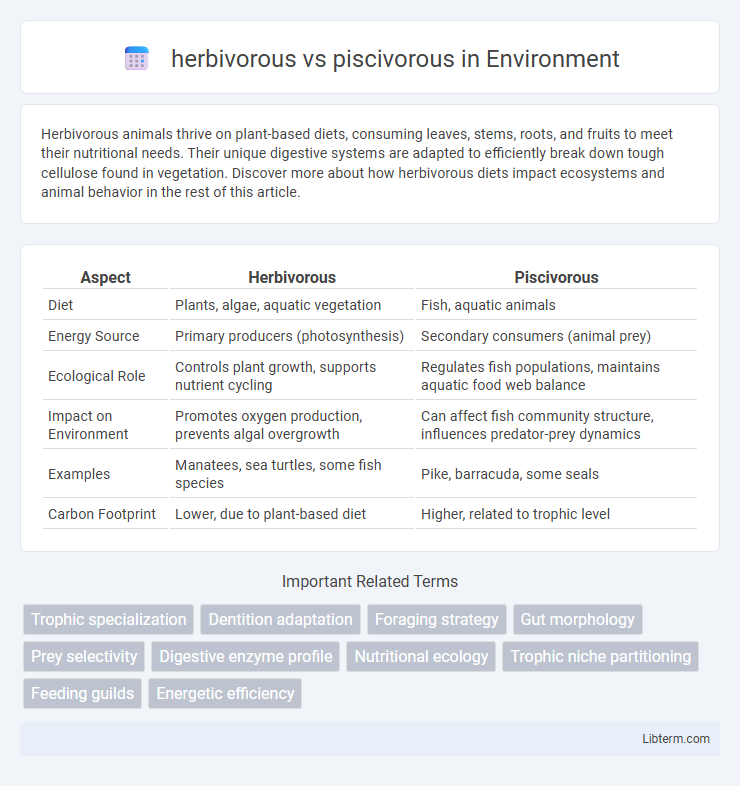Herbivorous animals thrive on plant-based diets, consuming leaves, stems, roots, and fruits to meet their nutritional needs. Their unique digestive systems are adapted to efficiently break down tough cellulose found in vegetation. Discover more about how herbivorous diets impact ecosystems and animal behavior in the rest of this article.
Table of Comparison
| Aspect | Herbivorous | Piscivorous |
|---|---|---|
| Diet | Plants, algae, aquatic vegetation | Fish, aquatic animals |
| Energy Source | Primary producers (photosynthesis) | Secondary consumers (animal prey) |
| Ecological Role | Controls plant growth, supports nutrient cycling | Regulates fish populations, maintains aquatic food web balance |
| Impact on Environment | Promotes oxygen production, prevents algal overgrowth | Can affect fish community structure, influences predator-prey dynamics |
| Examples | Manatees, sea turtles, some fish species | Pike, barracuda, some seals |
| Carbon Footprint | Lower, due to plant-based diet | Higher, related to trophic level |
Introduction to Herbivorous and Piscivorous Diets
Herbivorous diets primarily consist of plants, algae, and other vegetation, providing essential nutrients like fiber, vitamins, and minerals critical for growth and energy. Piscivorous diets are centered on fish consumption, rich in high-quality protein, omega-3 fatty acids, and essential micronutrients that support muscle development and brain function. Understanding the dietary distinctions between herbivores and piscivores helps clarify their ecological roles and nutritional adaptations.
Defining Herbivores and Piscivores
Herbivores are animals that primarily consume plant material such as leaves, stems, and fruits, adapting digestive systems specialized for breaking down cellulose-rich vegetation. Piscivores specialize in a diet consisting mainly of fish, featuring adaptations like sharp teeth and enhanced sensory organs to detect and capture aquatic prey efficiently. Understanding these dietary distinctions highlights ecological roles and evolutionary traits shaping feeding behavior in diverse species.
Evolutionary Adaptations for Different Diets
Herbivorous animals have evolved specialized teeth such as flat molars for grinding plant material and complex digestive systems with elongated intestines or multiple stomach chambers to efficiently break down cellulose. Piscivorous species exhibit sharp, conical teeth and streamlined bodies optimized for catching and consuming fish, along with digestive enzymes adapted to process high-protein, lipid-rich prey. These evolutionary adaptations highlight distinct morphological and physiological traits enabling herbivores and piscivores to exploit their respective food sources effectively within diverse ecosystems.
Digestive System Differences
Herbivorous animals possess longer and more complex digestive tracts with specialized chambers like the rumen to break down cellulose in plant material, utilizing microbial fermentation for nutrient extraction. Piscivorous species have shorter, simpler digestive systems optimized for digesting protein-rich fish diets, featuring highly acidic stomachs to efficiently process animal tissues. The contrast in gut morphology reflects dietary adaptations, with herbivores requiring extended fermentation time and piscivores emphasizing rapid digestion and nutrient absorption.
Common Examples of Herbivorous Animals
Herbivorous animals primarily consume plant matter such as leaves, stems, and fruits, with common examples including elephants, cows, and deer, which play vital roles in maintaining ecological balance through grazing and seed dispersal. These animals possess specialized digestive systems like complex stomachs or elongated intestines to efficiently break down cellulose in vegetation. Unlike piscivorous animals that feed on fish, herbivores contribute to sustaining terrestrial ecosystems by supporting plant growth and preventing overgrowth through their feeding habits.
Notable Piscivorous Species
Notable piscivorous species include the great white shark (Carcharodon carcharias), which primarily consumes fish and marine mammals for sustenance, and the kingfisher (Alcedinidae family), known for its remarkable fishing skills in freshwater environments. Other prominent piscivores are the barracuda (Sphyraena genus), characterized by its sharp teeth and speed, and the ocelot (Leopardus pardalis), a wild cat that occasionally preys on fish. These piscivorous animals play a crucial role in aquatic ecosystems, regulating fish populations and maintaining ecological balance.
Feeding Strategies and Behaviors
Herbivorous animals primarily consume plant material, utilizing specialized digestive systems, such as elongated intestines and symbiotic gut bacteria, to efficiently extract nutrients from cellulose-rich foliage. Piscivorous species focus on fish as their main food source, employing hunting strategies like ambush predation, pursuit, or filter feeding, often supported by adaptations such as sharp teeth and enhanced sensory systems. Feeding behaviors in herbivores typically involve continuous grazing or browsing, while piscivores exhibit selective feeding patterns influenced by prey availability and habitat.
Ecological Roles and Impact
Herbivorous species play a crucial ecological role by regulating plant populations and facilitating nutrient cycling through the consumption of vegetation, which supports ecosystem stability and biodiversity. Piscivorous animals influence aquatic food webs by controlling fish populations, maintaining species balance, and preventing overpopulation of prey species that can disrupt ecosystem function. The interplay between herbivorous and piscivorous organisms shapes energy flow and trophic dynamics in both terrestrial and aquatic environments, impacting habitat structure and overall ecosystem health.
Nutritional Pros and Cons
Herbivorous diets provide high fiber and essential vitamins from plant matter but often lack sufficient proteins and omega-3 fatty acids vital for growth and brain function. Piscivorous diets offer abundant high-quality proteins, DHA, and EPA crucial for muscle development and cognitive health but may expose consumers to higher levels of environmental toxins such as mercury. Balancing these diets requires considering nutrient density, digestibility, and potential contaminants to optimize health outcomes in animals or humans.
Conclusion: Comparing Survival Strategies
Herbivorous animals rely on abundant plant resources, adapting digestive systems to efficiently extract nutrients from cellulose-rich diets, which supports stable populations in diverse ecosystems. Piscivorous species depend on aquatic prey, evolving specialized hunting techniques and sensory adaptations to capture elusive fish, often influencing aquatic food webs and predator-prey dynamics. Comparing these strategies highlights how dietary specialization drives evolutionary traits and habitat preferences, shaping survival and ecological roles across terrestrial and aquatic environments.
herbivorous Infographic

 libterm.com
libterm.com